Flames and Smoke from the Chimneys of Crematoria
Optical Phenomena of Actual Cremations in the Concentration Camps of the Third Reich
1. The Problem of Flames Spouting from Chimneys
A number of witnesses speak about flames they saw coming out of the chimneys of crematoria. In technical terms, this can be formulated as a question: is it possible for the combustion of unburnt gases to occur not only inside but also outside of the smoke ducts, thus producing the phenomenon of flames coming out of the chimneys?

Photo 1
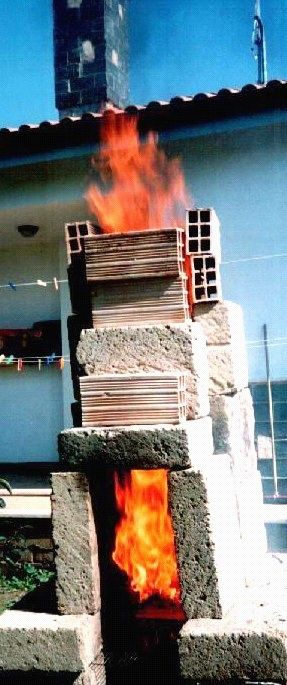
Photo 2

Photo 3
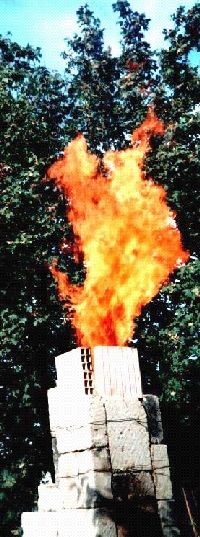
Photo 4
We shall investigate this problem on the basis of Crematoria II and III of Auschwitz-Birkenau, and specifically for furnaces number 3 and 4, which had the shortest flues. These flues had a cross section area of 0.42 m2 (0.6 by 0.7 m) and a length of 6.5 and 10.5 m respectively. Both fed into the duct of the central draft blower, which was about 2 m long with a cross section area of 0.8 by 1.2 m. The shortest smoke duct thus showed an average cross section area of 0.46 m2 and a total length of 24 m, including the smokestack.
The velocity of combustion gases in a chimney varies with the square root of the draft; in case of crematoria with coke-fired ovens it amounted to roughly 3 m/sec,[1] whereas for industrial furnaces it is in the order of 3 to 4 m/sec.[2] When assuming the higher of these values, we see that even in the shorter of the two ducts the combustion gases would remain (24/4=) 6 seconds in the smoke duct.
In modern incinerator plants for solid urban refuse the design is such that that the combustion gases will remain for 2 seconds[3] in an after-burning chamber held at 950°C; in electrically heated plants presently offered by the Swiss Brown-Boveri company (BBC), after-burning takes place in exhaust ducts, in which the combustion gases remain 1.3 to 2.3 seconds.[4]
For crematoria II and III at Birkenau this means that in the shortest duct the smoke remained 3 times longer than would have been necessary for its complete combustion. Therefore, it was impossible for any flames to be observed on top of those chimneys.
1.1. An Experiment with a Flaming Chimney
In order to test the correctness of those conclusions, I have carried out several combustion experiments with animal fat in a field oven, in which flames did come out of the chimneys. The set-up consisted of two grids, a lower one being a hearth for firewood and an upper one to take up the fat. On the latter, I placed an aluminum pan, 33 by 25 by 5 cm, containing 400 grams of lard (pork fat) and then lit the wood on the lower grid.[5]
Once the fat had melted, it eventually began to boil and the vapors caught fire immediately. The flames developed a few centimeters above the boiling fat, which remained clearly visible (see photographs 1 and 2). During the most intensive combustion phase the flames came shooting out of the chimney reaching a height of 1.5 m above the top opening of the chimney and over 2 m above the pan with the boiling fat. (see photographs 3 and 4). Combustion lasted for approximately 5 minutes.
This phenomenon can be explained as follows: the volumetric flow rate of the combustion gases, which were generated by the decomposition of the fat, was greater than their combustion rate; thus, the gases remained in the combustion chamber for less time than would have been necessary for complete combustion. Therefore, combustion took place outside of the combustion chamber and even outside of the chimney.
Two more experiments were carried out in order to test this explanation.
1.2. Combustion Test with Animal Fat in a Combustion Chamber with Short Chimney (January 10, 1995)
The experiment was carried out in a field oven built from blocks of tuff and equipped with two grids, the lower one for wood and the upper one for the fat. The combustion chamber had a volume of some 0.05 m3 and was connected to a chimney having a cross section area of 0.27 by 0.27 m and a height of 0.54 m, set about 10 cm above the upper grid. On this latter grid, I placed an aluminum vessel 22 cm by 17 cm in size, containing 200 grams of lard. Then the hearth was loaded and the wood was lit. A few minutes later, the boiling lard caught fire and flames came shooting out of the chimney to a height of 70 cm above its base (see photographs 5 and 6). Complete combustion of the fat took 3 minutes with the most active phase lasting about 2 minutes and 45 seconds.
1.3. Combustion Test with Animal Fat in a Combustion Chamber with Long Chimney (January 10, 1995)
In this case, I removed one layer of tuff blocks from the chimney of the oven and installed there an ordinary stovepipe 2.10 m in length and having a cross section area of 0.40 by 0.20 meters. The total volume of the combustion chamber was therefore about 0.20 cubic meters. On the upper grid I placed an aluminum vessel similar to the one previously used but containing 300 grams of lard. I then loaded the hearth and lit the wood. As before, the fat quickly caught fire, but no flames or individual bursts of flames came from the chimney (see photograph 7). The fat was consumed within 3 minutes and 45 seconds with the most intensive phase lasting 3 minutes and 30 seconds.
1.4. Conclusions
The two tests were similar in nature, the difference being that a stovepipe was used in the second case. In spite of more fat being used in the second experiment, no flames came out of the smokestack opening, because the gases generated by the decomposition of the fat in a combustion chamber four times as large were burned completely within the chimney.
As these are results of a physico-chemical type, they can be applied in proper proportions to the Birkenau crematoria.
1.4.1. Crematoria II and III
- Volume of the shortest smoke duct (including chimney flue): 0.46 m2 by 24 m in length = 11.04 m3 = ca. 11 m3
- combustion chambers: 1.5 m3 × 3 = 4.5 m3
- total volume: 11 + 4.5 m3 = 15.5 m3
Applying the conditions of the first experiment: 0.2 kg of fat in a volume of 0.05 m3 over 3 minutes, corresponding to 4 kg of fat in 0.05 m3 per hour, i.e., 80 kg of fat per m3 per hour or a total of 15.5 × 80 kg = 1,240 kg of fat per hour in the total combustion volume.
We see that flames would have come out of the chimney if 1,240 kg of lard had been burnt per hour in the three muffles.
Applying the results of the second experiment: 0.3 kg of fat in a volume of 0.2 m3 over 4 minutes, corresponding to 4.5 kg of fat in a volume of 0.2 m3 per hour, i.e., 22.5 kg of fat per m3 per hour or a total of 15.5 × 22.5 kg = about 350 kg of fat per hour in the total combustion volume.
Thus, it would have been possible to burn some 350 kg of fat per hour in the three chambers of this oven without any flames appearing at the top of the chimney.
We are talking here about pure fat. Therefore, the phenomenon of flames coming out of the chimneys would have been physically impossible in the case of the incineration of three corpses per hour in the three chambers of that oven, because, actually, the fat content of three corpses weighing about 70 kg each is only about 25 kg, whereas 350 kg of fat would correspond to about 42 such corpses. I have not taken into account the combustion of body proteins because proteins burn considerably more slowly than fat.
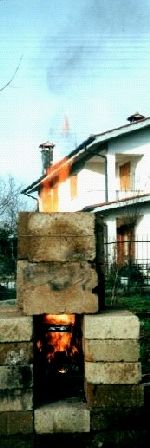
Photo 5
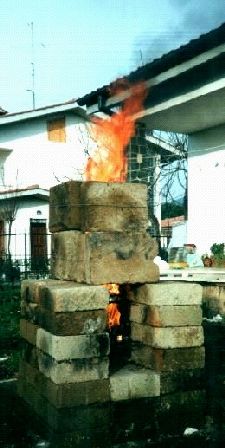
Photo 6
1.4.2. Crematoria IV and V
Crematoria IV and V had two chimneys each, one for each group of four muffles. The total volume available to the combustion gases (chambers, duct, and flue) was about 18 cubic meters. If we apply the same reasoning as before, we obtain:
a) for the first experiment
80 kg of fat per hour per m3 of chamber volume, i.e., 80 × 18 = 1,440 kg of fat per hour for the 4 chambers.
It would have been possible to observe flames above the chimneys if 1,440 kg of fat per hour were burnt in the four chambers.
b) for the second experiment
22.5 kg of fat per hour per m3 of chamber volume, i.e., 22.5 × 18 = 405 kg of fat per hour for the four chambers.
No flames would have been observed even if more than 100 kg of pure fat (corresponding to 12 corpses) had been burnt in each of the four chambers.
1.5 Concluding remarks
The above considerations are based on a time unit of one hour, but it is obvious that the incineration of the total amount of fat contained in the corpses would have taken much less time. On the other hand, it is equally apparent that the combustion of this fat could not be controlled in the same way as was possible in the experiments described herein. The external fat and the internal fat of the corpses would have melted, evaporated and burnt over time in an irregular way, depending upon the vaporization and combustion rates. Hence, combustion of the total fat content of a corpse would have extended over a period of not less than 30 minutes. This, however, does not invalidate the results, because the upper limit of the non-verifiability of the phenomenon (flames from the chimneys) would have been the combustion of 175 kg of fat in 30 minutes for crematoria II and III, whereas in practice only 25 kg of fat were thus burnt. For crematoria IV and V the respective figures would be a limit of 202 kg of fat in 30 minutes as opposed to an actual combustion of only 34 kg of fat.

Photo 7
The above arguments do not mean that no flames would ever have come from these chimneys; we merely argue that the phenomenon is not directly related to the incineration, i.e., to the burning of corpses. As opposed to this aspect, the phenomenon may well occur as an indirect side-effect of the incineration, i.e., as a result of the combustion of the coke used as a fuel for these furnaces.
It is well known that under conditions of incomplete combustion carbonaceous fuels will produce carbon particles, which will deposit on the walls of the smoke ducts in the form of soot. Under appropriate conditions (if the soot layer is sufficiently thick and the temperature sufficiently high) the soot will ignite and flames will indeed emanate from the chimney.
In pre-war times, when the average European household was using wood, coke, or coal almost exclusively for home-heating, such cases were so common that the phenomenon was, on occasion, produced intentionally for scientific studies. For instance, in early 1933, such experiments were carried out in a nearly abandoned four-story building in Berlin.[6] A diagram shows that 95 minutes after the ignition of the soot on the first floor one meter above ground level the combustion temperature of the soot in the smokestack reached 1060°C. This is not really surprising, for soot consists of carbon having an ignition temperature of 700°C.
Obviously, this phenomenon will not occur continuously, but only at times, because it depends essentially on the accumulation of a sufficiently thick layer of soot, and that requires some time. It is clear that this phenomenon is unrelated to the reports of eyewitnesses who speak of flaming smokestacks as a direct consequence of the incineration of corpses. The most telling of such statements is that of Henryk Tauber who declared on 24 May 1945:[7]
"It was possible to charge up to eight 'muselmans' [in one muffle[8]]. Such big charges were incinerated without the knowledge of the head of the crematorium during air raid warnings in order to attract the attention of airmen by having a bigger fire emerging from the chimney"
The purpose of such false statements was obviously to give credence to the falsehoods concerning the mass incineration of purportedly gassed victims, such gigantic incinerations causing flames to shoot from the smokestacks.
2. The Problem of Smoke from Chimneys
The phenomenon of smoking chimneys is closely related to the above observations: if the flow rate of a combustible gas mixture in a combustion chamber is higher than its ignition rate, the mixture will not ignite inside the chamber but outside of it, provided conditions remain constant. If, however, conditions do not remain constant, i.e., if the temperatures in the flue and the smokestack are lower than the ignition temperature of the gas mixture, the gases will leave the smokestack unburnt or only partially burned in the form of smoke.
No official historian has taken the problem of smoking chimneys at Auschwitz into consideration, except for Jean-Claude Pressac who discussed it in 2000, rejecting it outright. We shall consider both his technical arguments and his reasons for rejection in the following section.
On June 15, 1995, Pressac gave a long interview to a certain Valérie Igounet, the content of which was obviously reworded before publication. Pressac declared:[9]
"At the first European congress on cremation, which took place at Dresden in 1878,[10] strict rules were put down regarding the procedure of the incinerations. Firms building such ovens[11] had to respect such rules. One of the rules stipulated that 'the products of the incineration must not harm the environment.'[12] Smoke and noxious odors were prohibited.
The Topf company, from its very beginnings a producer of furnaces of all kinds, was very wary of smoke generation, as this indicated a poor functioning of the hearth. One of its leaflets appealed to clients by saying: 'If your chimney smokes, you are losing money.' The Topf incineration furnaces did not smoke, nor did those of the competition. […]
When, after his arrest in March 1946, Kurt Prüfer was interrogated by the Soviets on the subject of the crematoria in the concentration camps, he explained their design details. Ovens for civilian use operated with pre-heated air, which caused the corpses to burn rapidly and without smoke.
The ovens in the camps being of a different design, such a measure could not be applied. The corpses burnt more slowly and smoke did develop. In order to prevent this from happening, it was sufficient to blow air into the incineration chamber.
The three double-muffle ovens of crematorium I in the Auschwitz Stammlager were indeed equipped with blowers. This also applied to the triple-muffle ovens at Buchenwald and crematoria II and III at Birkenau. Prüfer, by using a technique identical to the use of bellows to fan the fire of a blacksmith, achieved a combustion time approaching that of civilian furnaces and was able to avoid smoke generation. On the other hand, the eight-muffle ovens of crematoria IV and V did not have blowers, but this lack was compensated for by the strong draft generated in the two 16-meter smokestacks. Regarding the ovens produced by the Kori company in Berlin, these were fired with fuel oil or coke and were fabricated or built without blowers."
It is no doubt true that crematoria were not supposed to smoke, in accordance with the pious wishes of their promoters. It is, however, also a fact that all furnaces, in particular those using coke as fuel, did smoke to a greater or lesser extent. Instead of looking at the cremation diagrams, Pressac satisfied himself with the "rules."
For instance, the oven used in the Dessau crematorium by the engineer Richard Kessler for his experiments in 1926 and 1927 (fifty years after the Dresden meeting) smoked invariably in all cases and with any kind of fuel used – coke, gas, or (brown coal) briquettes. Kessler, it must be remembered, was one of the foremost German authorities of his day in the field of cremation. For his tests, he used an oven manufactured by the Beck Bros. company of Offenbach with some of his own improvements; it was in no way inferior to the Topf ovens.
The diagrams illustrating the operation of the oven included a graph for the "representation of smoke development," which distinguished between three colors of smoke, viz. "black," "dark," and "light." The draft indication for the grid was two-fold and distinguished between the force of the draft at "normal combustion" and at "smoke combustion." The first combustion using gas (the oven was equipped with a gas burner in addition to a gas generator) resulted in smoke for something like an hour: During the second and the seventh cremation with coke, smoke was produced for approximately 20 minutes.[13]
In the 1940s, the problem was still so acute that another specialist of cremation, the Swiss engineer Hans Keller decided in 1944to study it scientifically. He published his findings in an article entitled "Causes of smoke generation during cremation."[14] It follows that civilian furnaces regularly produced smoke.
We will now consider the interrogation of the Topf engineer Kurt Prüfer by Captain Shatanovski and Major Morushenko of the Soviet anti-espionage organization Smersh. On March 5, 1946, Prüfer declared:[15]
"In civilian crematoria, preheated air is injected by means of special bellows, making for a rapid and smokeless incineration of the corpse. The design of the crematoria for concentration camps was different; it did not allow preheating of the air and thus resulted in a slower combustion of the corpse and in the production of smoke. In order to reduce the amount of smoke generated as well as the odor of the burning corpse, a ventilation was employed."
Thus, according to Prüfer, the smokestacks of the Topf ovens installed in the concentration camps did indeed smoke, and the installation of an air blower (translated erroneously as "ventilatsia," ventilation, in the Russian text), while reducing the smoke, did not eliminate it completely.
By contrast, Pressac argues that for an elimination of the smoke it was sufficient "de pulser de l'air dans le creuset incinérateur" (to pump air into the incineration chamber) – as if the phenomenon were simply caused by a lack of combustion air. In reality the coke ovens operated with an enormous excess of air. Experience shows that the smoke is caused
- either because the combustion gases are cooled down too much in the recuperator or in the flue, to the point that there is no after-burning,
- or because of an inability of the smokestack to handle the gases (as asserted by Keller),
- or (as was the case in the first electric oven built by Topf for the Erfurt crematorium) because the draft in the chimney is too high, causing coal particles, which constitute the visible smoke and the soot, to leave the smokestack unburnt.
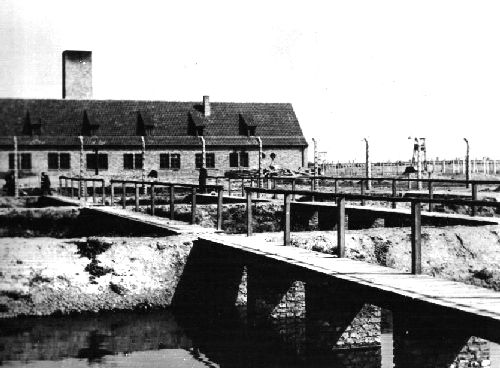
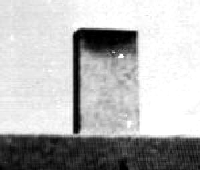
Photograph 8: Soot deposits on the outside of the chimney of crematorium II at Birkenau (right: enlarged view)[16]
In any case, the injection of cold air into the muffles (the Topf ovens at Auschwitz did not possess any device for preheating the combustion air) would have caused nothing but a worsening of the problem and yet more smoke. Prüfer's explanation is technically unfounded. His attempts at reducing the smoke not only did not reduce it, they made matters worse.
With respect to the specific topic of the Topf ovens at Auschwitz, it would be technically erroneous and in contradiction with obvious facts to maintain that they did not smoke. These ovens, as we have seen, were not equipped with the technical devices to monitor the production of smoke (flue gas analyzers) or to prevent it (such as the recycling loop to burn smoke as used at Dessau), which civilian ovens possessed. Their coarse and simple design invariably led to smoke generation.
In this regard, it is sufficient to realize that for the triple-muffle oven, the most common type at Birkenau, the blower, which fed combustion air into the muffles, could not be controlled individually for each chamber; moreover, combustion in the three muffles was controlled by a single flue damper. Hence, optimum combustion control for the three muffles was impossible in practice, but not even that would have eliminated the smoke. In crematoria IV and V, the situation was even worse, because a single damper served four muffles!
On the other hand, on the subject of a photograph of crematorium II at Birkenau taken in the summer of 1943, Pressac writes in his first book:
"The crematorium had already been in use as can be seen from the soot near the top of the chimney."
It is indeed possible to distinguish soot deposits at a level of over 15 meters on the outside of the chimney (see photograph 8). This means that, when the ovens were in operation, the chimney did produce smoke, and not just a little bit. Pressac is, therefore, in contradiction not only with the facts but with himself as well.
Pressac's argument – that the eight-muffle ovens of crematoria IV and V compensated for the absence of suction blowers "by a strong draft" made possible by the two 16-meter chimneys – is profoundly absurd, because the height of the chimneys for crematoria II/III and IV/V was practically identical (15.46 vs. 16 m), and their cross section areas were also proportionally identical. For crematoria II/III, each of the three channels making up the chimney had a cross sectio arean of 0.96 m2 and served six muffles, whereas each of the two chimneys at crematoria IV/V had a cross section area of 0.64 m2 and served 4 muffles. A simple comparison shows that the relative areas per muffle were identical (0.64÷0.96=4/6)!
Finally, Pressac's assertion that in the Auschwitz crematoria it was possible to achieve a combustion rate approaching that of the civilian furnaces, thanks to the blowers (i.e., the duration of the incinerations was reduced), lacks any technical basis. In the Topf ovens supplied to Auschwitz, the air ducts coming from the blower ran transversally through the upper rear portion of their brickwork. Perpendicular to them, secondary ducts ran lengthwise above the vaulted ceiling of the muffles and connected to four openings in this ceiling.
Thus, combustion air was fed into the muffles from above. A similar air injection system had already been tested in the gas-fired ovens I and II of the Zurich crematorium (1931-1932). According to professor Paul Schläpfer (1938), experience showed this system to be inefficient:[17]
"In addition, the air is fed into the muffle from the top and then flows down along the side walls absorbing heat. The muffles are thus cooled on the inside. The combustion gases are made to flow directly downward, and the important initial heating-up of the muffle does not occur. […] Also in the case of oven-types I and II, feeding air from the top turns out to be counterproductive, as the duration of combustion is extended [from one hour] to 1 1/2 hours, and the oven has to be reheated briefly after each incineration."
To underpin his arguments, Pressac refers us to Prüfer, the designer of the triple-muffle and the eight-muffle furnaces of Birkenau, but his efforts go up in smoke and the French researcher entangles himself in a web of contradictions. In his second book he had, in fact, asserted that the capacity of crematoria II/III at Birkenau had amounted to 1,000 corpses per 24 hours.[18] If we compare this to Prüfer's statements under interrogation on 5 March 1946,[19] as quoted by Pressac, we find:
"Question: How many corpses could be burnt in one of the Auschwitz crematoria in one hour?
Answer: in a crematorium of five ovens or fifteen muffles, it was possible to burn 15 corpses per hour."
Hence, a single corpse could be incinerated in each muffle of the five triple-muffle ovens, or theoretically 360 corpses in 24 hours.
Let us recapitulate: when the Birkenau ovens were in operation, the chimneys of the crematoria smoked continuously. This could not be avoided, because
- the triple-muffle and eight-muffle furnaces did not have any recuperators for preheating the combustion air;
- in the triple-muffle furnaces, the air blowers could not be controlled individually for each muffle;
- the cold air fed into the muffles from above cooled down the walls of the muffles and caused the temperature to drop;
- a single damper controlled the combustion in the three muffles;
- in the eight-muffle types, a single damper controlled the combustion in four muffles
Moreover, the top of the chimney of crematorium II was black with soot.
But why did Pressac ignore even an obvious proof in the form of a photograph? The answer is simple: he could not allow the chimneys of the Birkenau crematoria to smoke, because the aerial photographs known to him (which show no smoke coming from the chimneys) were taken at a time when mass gassings and incinerations were supposed to have taken place and thus the crematoria could not, under any circumstances, have been inactive.
This question is to be investigated in a further article.
Notes
First published as "Flammen und Rauch aus Krematoriumskaminen" in Vierteljahreshefte für freie Geschichtsforschung, 7(3&4) (2003), pp. 386-390; translated by Thomas Dunskus.
| [1] | W. Heepke, Die Leichenverbrennungs-Anstalten (Die Krematorien), Verlag von Carl Marhold, Halle a. S. 1905, p. 74. |
| [2] | G. Salvi, La combustione. Tamburini Editore, Milan 1972, p. 620. |
| [3] | Manuale dell'ingegnere. Nuovo Colombo. Hoepli, Milan 1990, p. E-740. |
| [4] | BBC-Elektro-Kremationsöfen im Dienste der Feuerbestattung, undated leaflet. |
| [5] | For a more detailed descritption and for more views of the oven used see the previous article in this issue "Combustion Experiments with Flesh and Animal Fat." |
| [6] | Ing. Kristen, "Ausbrennversuche an Schornsteinen," in: Wärmewirtschaftliche Nachrichten für Hausbau, Haushalt und Kleingewerbe, 6(7) (April 1933), p. 83-85. |
| [7] | Jean-Claude Pressac, Auschwitz: Technique and operation of the gas chambers. The Beate Klarsfeld Foundation, New York 1989, p. 489. |
| [8] | Camp jargon for 'emaciated inmates.' |
| [9] | V. Igounet, Histoire du négationnisme en France. Éditions du Seuil, Paris 2000, p. 648f. |
| [10] | Actually, the congress took place on June 7, 1876 |
| [11] | At that time, there was as yet no producer of incineration ovens. |
| [12] | The quotation is not quite exact, the text actually reads: "Es dürfen keine übelriechenden Gase entstehen, die Verbrennung muß also geruchlos sein." (No evil-smelling gases must be produced, hence, incineration must be odourless). M. Pauly, Die Feuerbestattung, Verlagsbuchhandlung von J.J. Weber, Leipzig 1904, p. 15. |
| [13] | R. Kessler, "Rationelle Wärmewirtschaft in den Krematorien nach Maßgabe der Versuche im Dessauer Krematorium," in: Die Wärmewirtschaft, 4(8) (1927), pp. 150, 154, and 156. |
| [14] | H. Keller, Ursache der Rauchbildung bei der Kremation. Bieler Feuerbestattungs-Genossenschaft, Jahresbericht 1944, Biel 1944. |
| [15] | J. Graf, "Anatomie der sowjetischen Befragung der Topf-Ingenieure. Die Verhöre von Fritz Sander, Kurt Prüfer, Karl Schultze und Gustav Braun durch Offiziere der sovjetischen Antispionageorganisation Smersch (1946-1948)," Vierteljahreshefte für freie Geschichtsforschung, 6 (4) 2002, p. 404. |
| [16] | APMO, Neg. Nr. 20995/460. |
| [17] | Betrachtungen über den Betrieb von Einäscherungsöfen, in: Schweiz. Verein von Gas- und Wasserfachmännern, Zürich 1938, p. 155f. |
| [18] | J.-C. Pressac, Die Krematorien von Auschwitz. Die Technik des Massenmordes, Piper Verlag, München-Zürich 1994, p. 200. |
| [19] | J. Graf, op. cit. (note 15), p. 404. |
Bibliographic information about this document: The Revisionist 2(1) (2004), pp. 73-78
Other contributors to this document:
Editor’s comments: First published as "Flammen und Rauch aus Krematoriumskaminen" in "Vierteljahreshefte für freie Geschichtsforschung," 7(3&4) (2003), pp. 386-390
